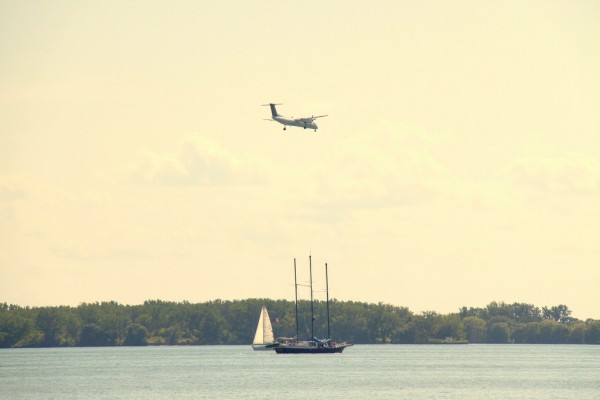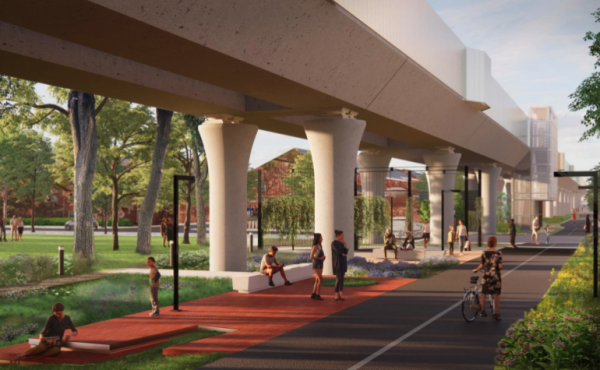Let’s play fill in the blanks: Jets are to the Toronto harbour as _________ is to Crimea.
Okay, okay. I acknowledge the comparison may be over-reaching just a tad. But as the independent aviation analysts with Transport Action Ontario (TAO) made clear at a press conference yesterday, the geographical contours of a jet-based airport – runways, approach lighting, marine exclusion zones (MEZ) and the so-called “precision approach” flight path – will, uh, occupy much more of the harbour than was previously understood, or officially acknowledged.
As one speaker trenchantly noted, Porter’s jet proposal will be profoundly transformative – no longer will Toronto have an airport on the waterfront. We’ll have a waterfront within an airport.
As executive committee convenes this morning to mull over a staff report that recommends an elaborate set of pre-conditions, including a new agreement with the Toronto Port Authority to impose hard passenger and slot caps, the TAO group, together with veteran planners Ken Greenberg and Paul Bedford, will urge the members to “just say no.”
But the staff report that was released last week — which recommends punting the decision until next March due to a dearth of data about the Bombardier CS-100s that Porter wants to use at the facility — doesn’t quite say no.
Rather, it lays out an elaborately phased set of hurdles that TPA and Transport Canada must meet before council can proceed with an amendment to the Tripartite agreement. These include adopting measures to contain noise and deal with road congestion, completing an environmental assessment of the runway extension, negotiating an airport master plan, and, obviously, ensuring that all the regulatory approvals are in place.
Last year, council also added another condition: that any new activity on the airport not encroach on the Western Gap.
The TAO’s 62-page report shows that the staff report failed to describe in detail the potential impact on the harbour of the safety measures used by Transport Canada for runway approaches at airports across the country. Because jets fly in at a shallower angle than propeller planes like the Q-400, they require a longer approach and depend on navigation lights when landing in low visibility conditions.
Consequently, the footprint of the whole operation could be far larger than what Porter is proposing. It encompasses much of the Western Gap, a swath of the inner harbour that extend as far as Harbour Square, and some of the Portlands. The Port Authority, says the TAO, would also need to set up a line of navigation lights in the middle of the harbour, forcing the Hanlan’s Point ferries to change their route.
The imponderable in all this is whether Transport Canada grants Porter and the yet-to-be-launched CS-100s an exemption from rules that govern all other airports in the country. “There’s no prospect of meeting the stringent conditions set by the City of Toronto and Transport Canada unless the exemption is granted,” said TAO president Peter Miasek. “Safety will overrule all other uses of the harbour.”
It’s difficult to know why council would proceed with a rush vote, as urged by deputy mayor Norm Kelly and mayoral candidate Karen Stintz, in the absence of much more precise information from the agency that controls the future of the proposal. Transport Canada has not yet revealed its assessment of the plane, or the runway/MEZ requirements.
But one could reasonably ask why the government, which asserts its regulatory authority in the interest of public safety, would opt to withdraw from that fundamental obligation in one of Canada’s most densely populated areas.
Then there’s the issue of the risks and liabilities associated with an exemption that allows jets to use the facility. Do the city’s insurance premiums rise because jets will be landing and taking off so close to key pieces of municipal infrastructure? Does an official exemption from Transport Canada protect the Port Authority, or Porter for that matter, from liability lawsuits in the event of a crash or collision? The island ferry, TAO analysts pointed out, is high enough to protrude into the flight path of incoming jets. What if a careless skipper someday steered his craft into the MEZ and it’s struck by a plane. Who pays?
None of these questions, which all involve money as well as safety, are thoroughly addressed in the staff report.
Nor, indeed, is the other big money question – how to pay for the ground-side infrastructure required to sort out the transportation tangle created by the airport.
The report hints at the possibility that the city, the TPA and the federal government could negotiate some kind of quid pro quo understanding that would lead to investments in transit or road improvements in exchange for council approval for the jet service.
If council decides to ground Deluce’s jet plan, the City will likely have less leverage to extract financial contributions from Ottawa or the TPA. Adam Vaughan, however, believes the City can still pressure the Port Authority or the federal government to help pay for transportation improvements that will make the status quo airport function more efficiently as passenger volumes continue to grow.
Ultimately, the most salient question for the executive committee and council (April 1) is to ask whether there’s any point in proceeding with a tremendously costly and time-consuming assessment process that seems designed to tell us that there’s almost no way to reconcile current and future harbour uses with the proper safety requirements needed to accommodate a jet-based airport.
“If permission is granted for jets,” said Bedford, “I believe the market will prevail, and the city will lose control over decision-making on the waterfront.”
photo by Wylie Poon






17 comments
There’s a lot of sound and fury, especially since with the Fords and Del Grande going off council this October Deluce probably fears one or more of their replacements won’t be easily sold on it. My gut instinct is that it will not pass, and Porter/TPA don’t deserve it to. If I was a Porter shareholder I’d be alarmed at the brand damage being done here. The Feds are shameless so the ducking and weaving from Mark McQueen and his colleagues won’t bother them any.
Bombardier are rattling sabres about deadlines (remember the downtown streetcar order, when they managed to convince Council they were willing to walk away from North America’s biggest street rail vehicle order in decades, forcing the City to assume 2/3 of the order cost rather than 1/3?) but they have more to lose than Porter if C-Series loses an early customer given their own inability to meet production stage dates. Continuation of Porter as a major Q400 customer will on the other hand keep theirs off the market and the Downsview plant in employment.
The important thing for the City is, now that political consensus is for airport retention but not expansion, is immediate focus on how to lessen private vehicle and taxi mode share on Lower Bathurst. The reactivation (finally!) of Queens Quay West and 509 streetcar will help but it’s time the shuttle was replaced with full TTC routes which both serve the airport and provide additional movement options for those living on QQW and working in the business district north of Front Street, or travelling there to visit Ireland Park or other local traffic generators.
I have just completed reading the TAO report, which is very illuminating about the potentialities surrounding the proposed BBTCA expansion in ways that I have heretofore not seen considered.
I am a member of the National Yacht Club, which, along with the Alexandra Yacht Club, is adjacent to the Western Gap. Even if one discounts the considerable noise and the fumes over and above the current level, the extensions of the existing MEZs will likely lower the appeal of our site to the point where it would be impossible to continue. Do the Feds and the TPA propose blasting a ship canal through Ontario Place? We can’t leave if the assumed (on good, Transport Canada-mandated grounds) new MEZs go in.
I would imagine the same fate would await (perhaps paradoxically) of the TPA-run Marina Quay West and Pier 4, access to both of which would be very constrained by the new, expanded and jet-friendly MEZs.
It would be interesting to hear the viewpoints of the executives of Royal Canadian Yacht Club and Island Yacht Club and Toronto Island Marina: All of them would see their boating activities truncated by these extensions. Contrary to what may be public perception, not all yachters are wealthy or even privileged; clubs around Toronto Harbour, including NYC, run extensive learn-to-sail programs for adults and children, and summertime Junior sailing (seven to 16 years old) is currently done either close to or inside the assumed MEZ extensions. So is a program called Broad Reach, a registered charity which teaches underprivileged kids how to sail in donated race boats that brush the 18-metre mast height.
So while the concerns of sailboaters may seem only a small part of the mix, we aren’t all in possession of big Beneteaus. Some of us are teaching your kids how to sail, an activity best done without, I think, the roar, blast and stink of commuter jets in a situation reminiscent of the notoriously crowded Kai Tak airport in Hong Kong prior to its closure in 1998. We’ve seen this future, and it’s in the past.
I find the position of the mayoral candidates on this issue interesting. I voted for David Miller the first time because of his firm position on the island bridge, not for his other ideology.
I am now in a position where I will be voting for Olivia Chow for the same reason.
Bottom line is that expansion (with or without jets) will degrade the cultural and recreational environment of the central waterfront, which is one of Toronto’s crown jewels.
Some of the BBTCA background reports draw comparisons to London City Airport, which is in an old industrial district. A more apt comparison would be if London City Airport was on one site of Hyde Park.
Let’s play fill in the blanks: Jets are to the Toronto harbour as _________ is to Crimea.
Is the answer freedom. People want it, but they will not get it.
Will nobody think of the Yachters? Remember, they are not privilaged, they only want to live virtually rent and tax free in gated enclaves within a park, and dictate how others use the waterfront. And don’t forget they help people from time to time.
I really didn’t have an opinion on this one way or the other but all the safety zoning & other things make me inclined to say Toronto doesn’t need the headaches going forward with this. Not without a lot more information. There’s no need to rush this.
Hello Corby — check out Broadreach Foundation to moderate your views on people who sail.
The one thing I have not heard anyone mention about the airport expansion is the increased risk of terrorism. Unfortunately serious threats such as terrorism need to be talked about and are a very real concern. Not only is the airport a stones throw from the downtown core but it is also surrounded by an increasing number of condos that are being built at the highest rate in the world.
If the expansion goes through, the city will essentially have sacrificed the local condo dwellers for Deluce’s monetary gain. Plus, should a disaster happen, all the traffic clogging up the nearby roads going into the airport, will mess up any kind of quick emergency response. The whole proposal is so unsafe, its ridiculous it’s even still being talked about.
@Dustin — as it happens, the issue of the risk of terrorism and the island airport came up from time to time during the big debate that played out in the 2003 municipal race and in the run-up to the launch of Porter a few years later. But that was only a few years after 9/11, and now, for whatever reason, we no longer think much about planes flying into tall buildings.
Here is a link to a video of the Transport Action Ontario press conference:
https://www.youtube.com/watch?v=tgyXsA_eSC8&feature=youtu.be
Using Transport Action Ontario as the premise for this story is incredibly thin. To call this group “aviation analysts” is laughable. This report has no credibility coming from a group that wants to eliminate all regional flights. The assumptions are flawed and not based on the reality of operating at Billy Bishop airport.
This information essentially repeats claims from another report they issued last year and is only designed to distract people from making informed judgments. The runway proposals meet the city’s guidance to not have a material effect on boating in the Western Channel. Any suggestion otherwise is misinformed.
The CS100 is capable of using the same approach paths that the Q400 uses today, and there is no anticipated effect on boating from jet blast. The new geared-turbo fan engine with its high bypass ratio is a significant improvement in this respect from traditional jets. Taxing to the runway happens at idle power, so there is no affect for this procedure.
The bottom line is that city council will not approve a runway extension if it materially affects boat traffic. Porter is committed to this principle. The runway design is based on this and we will not proceed if this condition isn’t met.
Note the following disclaimer on page 52 of the current report. Effectively, they don’t know what they are talking about and shouldn’t be given credibility associated with professional researchers.
Disclaimer
Transport Action Ontario (TAO) is a Canadian non-government organization advocating for sustainable transportation. This report was written by a non-professional TAO researcher with some experience in airport and aircraft operations. While best efforts were made to provide quality research and analysis, no data or content in this report is guaranteed to be accurate or representative, and is intended for information purposes only. No responsibility or liability will be borne by TAO under any circumstances for any consequences of any actions or decisions taken by any person using this report.
Brad Cicero
Porter Airlines
Let’s look at the benefits touted for the Island Airport:
1. Quick proximity to the downtown core v.s. long travel to Pearson
2. Small scale, commuter style experience more suitable for day trips to regional destinations like Ottawa, Montreal, etc.
3. Frequent flights on smaller planes adding to scheduling convenience.
So how is this playing out?
1. Travel to Billy Bishop requires use of private transportation through a very congested area. Even the shuttles get backed up.
2. Expansion – how big will it get?
3. Larger planes and more destinations will require less frequency.
I’m baffled by the lack of sensible thought given to this. If we value those original benefits, as I do, why not work with an open mind to deliver those instead of getting sucked into supporting one (or more) corporate agendas? For instance, why has there been no discussion about opening the Downsview airport to commercial travel? The park there has become a white elephant, the cost of upgrading the facilities should be far more reasonable than filling in parts of the lake. There is a very convenient nearby subway stop that could be linked with a quick connections. I bet you could ride the subway from King and Bay to Downsview in roughly the same amount of time as waiting in that traffic jam at the foot of Bathurst.
Yes there are residential areas to consider, but Downsview is largely industrial and residentially sparse. Bombardier already flies there and there is plenty of runway space.
For a self-proclaimed expert on all issues related to transportation John Lorinc knows next to nothing when it comes to aviation. Look how much weight he has given to the “TAO” and a report that was written by a “non-professional” according to their own disclaimer!
The FACT is the CSeries is capable of landing at the same approach angle as the Q400 in fact at London City Airport the CSeries will be making even steeper approaches.
I think Porter offers a good service and enjoy using it from time to time. But when it comes to building a new runway out into the lake, that’s a different thing.
Who would pay for this? The Toronto Port Authority (in other words our taxes), not Porter. But Deluce sees Porter as the main beneficiary, talking about keeping caps on traffic, etc., with no reference at all to other airlines. He seems to think that we’ll build it, he will just expand his business, add some more flights and everything will be perfect.
Do we really want to build a taxpayer funded runway to benefit one business owner? Won’t Porter have to reduce it’s service if Air Canada (who has some flights there now), Westjet, etc. ask for access to what should be a major resource paid for by the public?
If this project goes ahead, it shouldn’t be the private domain of Porter Airlines.
Just to point out – the Toronto Port Authority is a self-sustaining entity that does not and cannot by law use taxpayer money. The expansion would be funded by airport improvement fees only charged to the people who fly in and out of the airport.
Rein said “Travel to Billy Bishop requires use of private transportation through a very congested area. Even the shuttles get backed up.”
Once the expansion gets knocked on the head, it would be nice for the local Councillor to start advocating for better transit connections to Eireann Quay rather than, as it seems, continue his long standing hope the airport will just go away. The political consensus in the city is, I feel, to retain – not expand, not close.